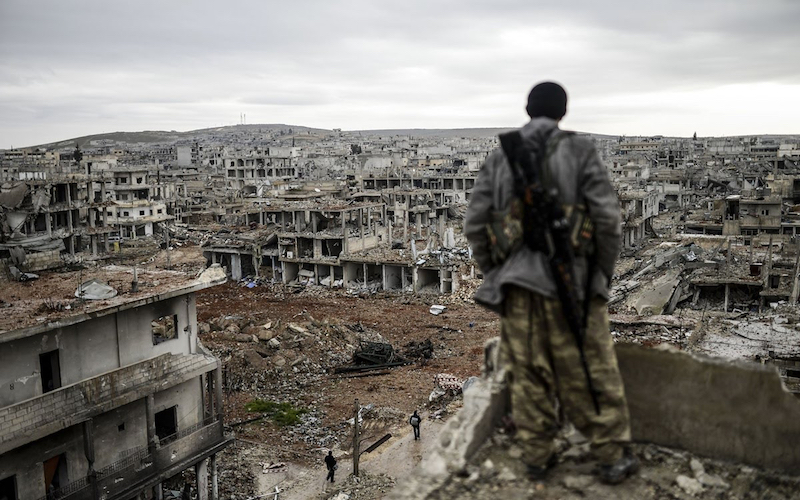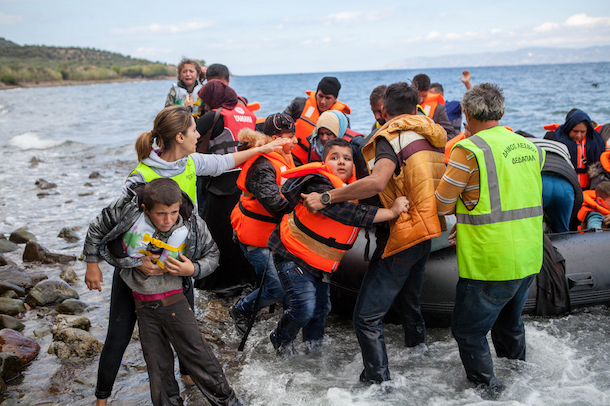
A Greater NATO Role in Syria
Since the onset of civil war in Syria, the United States’s only military action has been airstrikes and very limited special operations missions targeting ISIL. On April 6, that changed.
For the first time since the conflict broke out, the U.S. took direct military action against the Assad regime following a brutal sarin attack in Khan Sheikoun that killed more than 80 people and has been attributed to Damascus. The Syrian government and Russia, its most powerful backer, denies Assad’s responsibility.
Washington’s choice to bomb the Syrian government base from which the sarin attack was allegedly conducted is a significant departure from the Obama era policy of avoiding direct confrontation with Damascus. A week after the U.S. airstrikes were conducted, Secretary of State Tillerson remarked that Assad’s rule is “coming to an end” before flying to Moscow to meet with Russian President Vladimir Putin, Assad’s most powerful ally.
Six years into the civil war, massive violence persists despite Russia’s intervention and some gains against ISIL in Iraq and Syria. Considering the strong U.S. reaction to Assad’s latest chemical weapon attack on innocent civilians, heavier action in the region is on the horizon.
Considering this, NATO should do more to help bring the Syrian war, which has already resulted in hundreds of thousands of civilian deaths, to an end. NATO can have a much greater impact than U.S. unilateral missile launches against Assad, and NATO should not only stand with the United States but also take action. Specifically, NATO should create a no-fly zone on the Turkish-Syrian border and put boots on the ground.
Responsibility to Protect
A NATO intervention in Syria would have precedent. In 1999, NATO intervened in Kosovo to prevent ethnic cleansing of Albanian Kosovars at the hands of dictator Slobodan Milosevic. Without Western intervention, some experts speculate that Kosovars would have been eliminated from Serbia. Nonetheless, the atrocities of the Balkan Wars – most notably the Srebrenica massacre – were not halted in time to save thousands of lives. The international community’s failure to respond in the Balkans in part sparked the creation of a new paradigm: Responsibility to Protect (R2P).
It was with this principle in mind that the U.S. and NATO intervened in Libya in 2011 due to fears of a massacre of innocent civilians in Benghazi at the hands of dictator Muammar al-Qaddafi. The death toll could have been catastrophic as Qaddafi vowed to “cleanse” the “rats” of Libya “house by house.”
But R2P has hardly been uniformly followed. In 2013, when the United Nations confirmed that Syrian dictator Bashar Al-Assad had used chemical weapons against his own people, the international community ignored a previously announced red line. In 2012, President of the United States Barack Obama announced that the use of chemical weapons would not be tolerated, and yet tolerance was the exact policy pursued by the alliance toward Assad after he killing his own innocent citizens. Syria agreed to dismantle their chemical weapon stockpile by mid-2014 through an agreement with the Chemical Weapons Convention (CWC). However, the April 4 attack in Khan Sheikoun proved what the rest of the world didn’t want to believe: these deadly weapons remain in Assad’s arsenal.
Aside from the Assad regime, ISIL now controls swaths of land in Syria, where it is brutally killing civilians as well as opposing militants through barbaric practices. This terrorist group has also claimed responsibility for attacks in the U.S., Brussels, Paris, Turkey, Iraq, and elsewhere in the region. As an alliance, however, NATO has yet to make any significant effort aside from Global Coalition to Counter ISIL action in Syria.

Today, over 470,000 Syrians have died due to the conflict. More than one in ten Syrians has been wounded or killed. Additionally, there are over 4.8 million registered Syrian refugees and over 6.6 million internally displaced persons in Syria. Aleppo stands as just one symbol of the Syrian civil war: a once vibrant city left in ruins, reduced to concrete and steel falling on those city residents who remain. The catastrophic loss and degradation of life in that city reflects the countrywide devastation. Considering these astounding statistics and atrocities, it is shocking that NATO invoked R2P in Libya yet remains complacent on Syria.
By not making a decision of whether or not to take action in Syria, the U.S. and its NATO allies opened the door to a Russian intervention on behalf of the Assad regime. Russia’s backing of Assad would have been much harder to realize had NATO taken action sooner. With this lack of response, countries like Russia are better able to pick the winners and losers of this conflict. Furthermore, Russia’s aircraft have primarily bombed anti-Assad forces, striking ISIL only when it suits Moscow’s public messaging campaign or when ISIL threatens Assad’s forces. NATO should take further action in the region in order to ensure a resolution that favors its interests. As of now, NATO has no say in the outcome of the Syrian civil war.
After the Cold War, NATO took on a variety of new roles; one was as a protector of human rights across the globe. This was exemplified during interventions in Bosnia, Kosovo, Libya, and Mali. The R2P principle, endorsed by all members of the United Nations at the World Summit in 2005, was taken particularly seriously by the transatlantic alliance.
It is time for NATO to take it seriously again. In Iraq, an ISIL suicide bomber walked into the middle of a children’s neighborhood soccer game and blew himself up, killing 41 people. ISIL draws its strength from its hold in Syria, while wreaking havoc on other parts of the world. When children are no longer safe to play soccer and thousands of innocents are slaughtered, it is time for NATO to invoke R2P in Syria. If NATO fails to intervene in the conflict, then its post-Cold War mission of humanitarianism will have been a sham.
No-Fly Zone
NATO member Turkey has called for NATO or other Western partners to create a no-fly zone on Turkey’s southern border with Syria that stretches over 500 miles.
Criticisms of a no-fly zone note the risks given Russia’s deployments in Syria. However, as a former Obama administration official at the State Department argues, Russia would likely adhere to a no-fly zone. After Turkey shot down a Russian jet that had violated its airspace in November 2015, the lack of hard military response from Russia indicated that it greatly feared larger NATO involvement in the region.
Turkey would greatly benefit from the creation of a no-fly zone on its border. With nearly 3 million Syrian refugees in Turkey, the government has previously pleaded to the international community to create such an area. The most recent stream of fleeing refugees has come from Russia’s bombing of Aleppo. Assad’s bombing campaigns prior to Russia’s assistance were intermittent. Assad was not able to bomb at night or in bad weather. When Russia entered the conflict, a 24/7 bombing campaign took place, making it impossible for civilians to live in the areas being attacked by Assad’s forces. The number of refugees fleeing to Turkey and surrounding areas soared. Making this area safe for refugees would decrease the number of civilians migrating out of Syria.
Furthermore, the U.S. and Turkey currently clash over the former’s support of the People’s Protection Units (YPG), the Kurdish fighting force in Syria, as well as the presence of self-exiled Muslim cleric Fethullah Gülen in Pennsylvania. The YPG is the sister organization of the PKK in Turkey, named a terrorist organization by the United States and the EU. Currently, the PKK has resumed fighting with Turkish authorities with the goal of creating a Kurdish autonomous region in Turkey. By arming the YPG, the United States is backhandedly supporting the PKK, angering Turkey. Additionally, the Turkish government blames Gülen for orchestrating the attempted coup d’etat in summer 2016; he currently lives in Pennsylvania. The U.S. government is reluctant to extradite Gülen needing time to conduct a fair process within the rule of law. By creating a no-fly zone, the U.S. would garner better will with Turkey at a time of considerable tension.
Lastly, Turkey has seen action on its border. Mortar fire from within Syria has landed in Turkey, killing and injuring Turkish citizens. The Assad regime, an enemy of Turkey, could be purposefully harming Turkey to engulf Ankara in the war. ISIL has also brought fighting to the Turkish border and beyond; it claimed responsibility for a New Year’s terror attack in Istanbul that killed 39 people. Beyond the Assad regime, the likelihood that the violence in Syria will spill into Turkey is becoming more likely with each passing day as varying insurgency groups fight for control over territory. Given that Turkey is a member of NATO, the alliance should not allow for the possibility of instability to reach Turkey; otherwise, Turkey could eventually evoke Article 5 and force NATO assistance.
Controversy with the YPG
NATO members currently involved in the Syrian conflict have chosen to back insurgency groups in Syria and Iraq. The U.S. has worked closely with the YPG and the Peshmerga, the Kurdish fighters of Iraq, in order to fight ISIL. The U.S. created a train-and-equip program for the Syrian Democratic Forces (SDF); however, this group is mostly made up of the YPG, meaning that a byproduct of supporting the YPG’s fight against ISIL could also mean supporting the creation of an independent Kurdistan.
NATO faced a similar challenge years ago in Kosovo. NATO’s support for the Kosovo Liberation Army (KLA) legitimized the organization and encouraged its terrorist tactics. It also proved that the West could not support a fighting force claiming independence without also subsequently supporting that independent state. Furthermore, the Human Rights Watch and Amnesty International have criticized the YPG for arbitrary arrests, abuse in detention, due process violations, unsolved disappearances and killings, and the use of children in YPG security forces. The YPG denied basic rights and gave unfair trials to members of the Kurdish Democratic Party of Syria (KDPS), the Yekiti Party, and the Azadi Party in Syria. Western support of the YPG could later create more trouble in the region, and the YPG has not shown itself to be anything other than a strong fighting force against ISIL. In fact, some speculate that the YPG has coordinated with the Assad regime. As YPG forces moved into an area, the Assad militia knowingly retreated, indicating that the YPG’s goals in Syria diverge from those of NATO. It would not be wise for NATO to support such an organization to such a great extent.
Although NATO could easily continue its support for the Peshmerga in Iraq through train-and-equip to fight ISIL, it would have to take a new and innovative approach to Syria considering it needs to fight both ISIL and Assad. Although a no-fly zone may allay Turkey’s objections to aiding the YPG, it may also be in the U.S.’s best interest to no longer support a Kurdish insurgency group. Although wildly unpopular, NATO forces on the ground in Syria may be the only way to fight ISIL, retain positive relations with partners in the region, and not enable a possible terrorist organization.
Counter ISIL coalition airstrikes are not enough to bring an end to the Syrian crisis. NATO should launch a true humanitarian effort in the region to bring about stability. It can start by creating a no-fly zone on the Syrian-Turkish border. NATO can also put boots on the ground to fight against ISIL and Assad. Finally, Europe and NATO can take a more humanitarian approach to the refugee crisis, whether by taking in more refugees or providing more material support to countries like Turkey, Jordan, and Lebanon, which already host large Syrian refugee populations.
This is a bold strategy, and there are many hurdles in carrying out these plans, as Assad is supported financially and militarily by Russia and Iran. It would not be met without opposition from some key NATO members. However, action in Syria is vital for global security. The U.S. has now for the first time stood up to the Assad regime and taken considerable unilateral action. Perhaps now, more than ever before, there is the political will to take action These mandates have not yet been met, but considering the horrific scenes unfolding day after day in Syria, it is time for the international community to meet these requirements, and soon.

